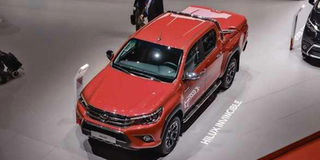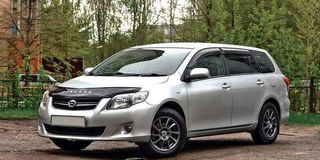
DN2
Premium
Baraza, I’m eyeing the KIA Optima, but it’s rare on our roads…
Hello Baraza,
I’m grateful for your wonderful insight on cars. I am looking to buy a KIA Optima (2014). It is a rare car on Kenya’s roads and I was wondering if this should be a concern. I am a first time car buyer and I just love sedans. Kindly advice on its reliability, fuel consumption, repair costs, and resale value. I live in Nanyuki and will therefore be using the car around and maybe take two monthly trips to ushago in Kiambu.
Danson
****
Hi Danson,
Your worries are not unfounded, a rare car means parts may be tricky to source and the necessary expertise required to keep them running may be lacking.
However, we do have a KIA dealership here in Kenya... rather, we should be having one, I don't know how active it is. There is something to this, too: I haven't test driven a KIA in lord knows how long: the last one I drove was a first generation Sportage which was not very good, but that was a dinosaur from KIA's formative years in the auto business, nowadays, these cars cause the Japanese sleepless nights because they outclass their Asian rivals in looks, build, quality and price.
You didn't specify what generation of Optima Sedan you have your eye on, so I'm going to recommend either the third or fourth generations. They're that good: reliable, at least more reliable than a lot of their Japanese rivals, fuel consumption is nothing to be afraid of, but repair costs could be fairly steep and steeped in inconvenience if the local franchise does not exist (the Google says there is a KIA Motors in Kenya so I guess that is a bullet dodged, but do they not have demo cars? And if they do, why haven't I tried one?)
Navigating between Nanyuki and Kiambu should not be cause for alarm. The connecting infrastructure is solid, blemish-free tarmac, it's just a shame that the thoroughfare is festooned by reckless drivers. Go for the Optima and bring some variety on our roads.
****

A Toyota Hilux Invincible car.
Greetings Mr Baraza,
Thank you for the good work you have been doing by sharing your views on motor vehicles. I am one of the beneficiaries of your articles. I would like to seek your opinion. We purchased an ex-UK Toyota Hilux Invincible 2016 model manual and its on its way to Mombasa. How is it when it comes to performance and durability? The same model though automatic transmission and ex-Japan is way much more expensive. What could be the major difference?
Thank you...
****
Hello Stranger,
I find it amusing that you want to find out about a vehicle after you have not just already committed yourself to the purchase, but gone ahead and done it. You are not the only one to do this, I have had a few other readers chime in with their own queries involving the words "I recently bought a [insert vehicular white elephant here] so could you please advise me about its (insert various parameters here, half of which are irrelevant while other half are terminal)".
Let me now ask a question of my own: if it turns out to be a complete pig and I ruthlessly take it to pieces via the vilest variation of vilification and calumny I can muster, to the point I get barred from ever speaking about that brand again - and you know I never lie, which is why you are here in the first place, what exactly are you and your compadres going to do? Put the vehicle on a ship back to the UK or Japan? Demand a refund from the people who sold you the car? Write me an email with your Caps Lock fully on using the kind of language that would make Li'l Jon blush demanding I say better things?
Anyway, here we are. You say you bought a UK-spec Hilux but you never specified what engine it has. Methinks it's a diesel, most Toyota SUVs and trucks sold on that rain-soaked oversized North Atlantic atoll are diesel-powered. It's highly likely the ocean-bound Hilux you will soon be driving has the 3.0 liter 1KD turbocharged 4-cylinder engine - or rather, for your sake I hope it does.
If it does then let me warm the cockles of your heart by declaring it's a good 'un. Just don't feed it trashy diesel, service it promptly and keep an eye on the coolant levels, you'll be A1. The 1KD is quite the performer, though I have no idea why you want performance out of a pickup, who do you want to race in it?
Allow me to paint a picture about the transmission. I test drove the previous generation Hilux, with a 2KD engine and a 5-speed manual and the one complaint I had was the mismatching of the gear ratios to the engine's torque characteristics such that 1st was short, 2nd and 3rd were long, then 4th and 5th were short again - almost the same ratio - meaning that highway speeds, where a diesel engine should be nestling quietly just above idle, the truck was roaring its lungs out at 3000rpm. I have a BMW that revs to 6500rpm and I had a Subaru that revved to 8500rpm and in both cars, highway speeds were a hair short of the same 3000rpm that this diesel powered truck needed to even approach 100km/h. The engine was good but that gearbox sucked.
I have also tried the same model of Hilux you are importing, in both original manual and post-facelift automatic versions and...what a difference! The manual had the relatively new 2GD engine mated to a six-speed box and it was really good to drive, I gave it glowing praise in a review I did back then, then I tried the facelifted 1GD-powered automatic and my mind was blown away. It was one of those demonstrators that I did not feel like giving back once the road test was over.
So, here is the thing about the price difference between the UK car and the Japanese one: it seems like the British version you are getting has the older KD-generation engine, probably the smaller 2KD, coupled to a 5-speed manual cogbox. The Japanese vehicle you compared it with probably has the newer GD-generation engine, perhaps the bigger 1GD plant, working in tandem with Toyota's 6-speed Super Intelligent ECT automatic transmission.
Both vehicles look like the same thing on the surface: a diesel-powered Hilux, but where all Hiluxes are equal, some are more equal than others. One may have an older, smaller engine with a somewhat inferior transmission while the other has a newer, superior, more powerful engine with a transmission controlled with more computer processing power and electronic intelligence than it first took to land man on the moon. QED, bro - Quod Erat Demonstrandum; Quite Easily Done.
As for durability - that "Invincible" tag is not a case of overselling, it's notoriously difficult to break a Hilux. The eighth generation car was specifically marketed as an improvement over the seventh generation one, of which a notable weakness was, well, a slightly weak frame; but this is a Hilux we are talking about, so that "weak" descriptor was relative and they were probably comparing it to a block of flats. Basically what they did was take an unbreakable car and imbue it with the kind of toughness that can withstand a point-blank volcano eruption.
Enjoy your new truck once it gets here...
Key:
KD engine: family of diesel powered Toyota engines that came in two formats: the 1KD which was more powerful owing to its larger capacity (3000cc) and was used in higher spec vehicles; and 2KD, a slightly less powerful 2500cc variant that was used in lower spec vehicles
GD engine: family of diesel powered Toyota engines that superseded the KD generation by introducing downsizing and increased thermal efficiency which improved both power and economy while optimizing smoothness and lowering emissions. Like the KD pair, there was the upper crust 1GD, good for 2800cc and the lower rung 2GD, coming in at 2400cc
Transmissions: in the eighth generation Hilux that you are buying, there were four transmission options to choose from: manual or auto, both available with 5 or 6 speeds each. More ratios mean better power distribution and the Super Intelligent ECT auto is the apogee of this lot. As stated earlier, while the names may sound hubristic, Toyota does not oversell itself; their tagging delivers exactly what it says on the tin.
****

A Toyota Fielder car.
I want a Fielder, but I want the best model…
Hello Baraza,
I am planning to buy a Toyota Fielder. We have 2014, 2013 and 2012 models that look similar and they look good. We also have a 2015 and upward models which look slightly different. Which one between the two models of Fielders should I buy? I want it and I am not looking at resale value or price, just a reliable Fielder.
Also if you can remember my inquiry about the Massey Ferguson tractor and New Holland tractor, in case of any information about them you can as well reply.
Thanks
****
Hi,
If in doubt, always go for the newer model, especially if we are referring to Japanese cars. The Fielder in particular, being a Corolla, just keeps getting better and better with every subsequent iteration, so the "2015 and upwards" model is the one you want here.
My information on tractors is rather thin since I don't engage much with them, and the farmers that use them are usually too busy feeding the nation to dabble in comparative chats about who prefers which brand and why. I would ask the respective dealers but all of them will claim theirs is better than the rest so that will lead nowhere productive.
Comparing tractors is very different from comparing cars: there is nothing like "first impressions", or acceleration tests, or handling tests, or interior space or practicality, tractors are measured against an ROI scale: return on investment. Those things cost more than houses do so ponying up for one means praying against hope that you recover your outlay in subsequent harvests if the rains hold their pattern, otherwise your goose is cooked. There is a reason why suicide rates are extremely high among farmers in developed countries. One wrong calculation means you will NEVER recover, ever.
So how does one test a tractor? Start with the initial cost, which is a long string of numbers that would shock a stock broker. To this add operational costs such as insurance, fuel consumption, maintenance and downtime. Deduct this figure from what you gather in a harvest that is the direct result of the efforts of this tractor, and factor in the uptime as well. You may or may include operator comfort. You may or may not include leasing fees, if you choose to lease out the vehicle to try and recoup the initial cost before the year 2250. Resale value comes at the bottom of this second column if you are unable to wait a full century for the tractor to "pay for itself".
So, as you can see, to do a thorough comparison test on tractors means owning a large farm and waiting through several planting seasons, meaning the response you are looking for may as well be pegged to Vision 2030, and much as the Motoring Press Agency has had an interesting decade-and-change of existence (12 years as of October 2021), our money is not that long, buying a farm and a couple of tractors just to come up with a 2,100-word article after several years is still a fair bit out of our league. Sorry.





